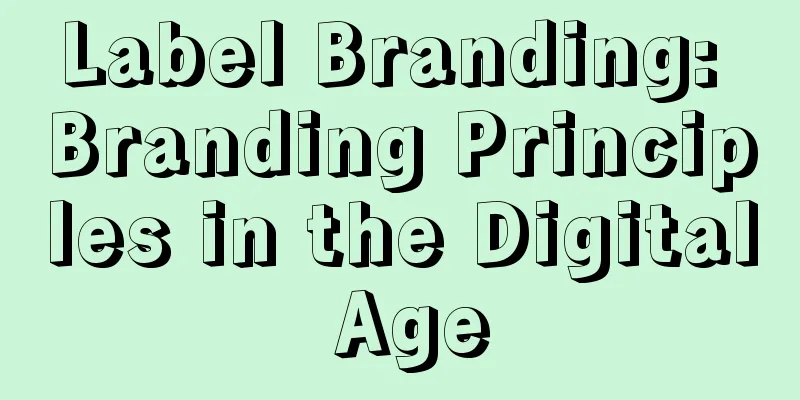Label Branding: Branding Principles in the Digital Age

The digital age calls for digital brand building methods. This is what we made clear at the beginning of the 30 Lectures on Brands, which is the general outline for understanding today’s brand strategy. Digitalization has completely changed our lives. 01First, digitization has changed the way we obtain information. In the past, people mainly relied on single indoctrination from television and newspapers, and a CCTV advertisement could quickly influence a billion people across the country. But today, people not only have more diverse information platforms, but also have the initiative to obtain information. We can search on our own, participate in topics and join discussions on social media, and major content platforms will also filter out content and information that you are more interested in. This has changed the way brands communicate. In the past, advertising was the center of brand communication, and communication was one-dimensional and centralized; now content has become the center, and communication is two-way and decentralized. Today, communication needs to emphasize more on consumer participation and interaction, and the communication should be able to form social diffusion. The practice of blindly spending money on media bombardment and trying to brainwash consumers, regardless of consumers' lack of interest (or even disgust), is becoming less and less effective. Secondly, digitalization has also changed the way we socialize. Today, we have a variety of social media accounts that make it easier to connect with friends and brands. People are scattered in various small circles online, such as communities and groups. This means that brand communication cannot only focus on exposure, but also consider how to break the circle and break the barriers between different platforms and interpersonal circles. Brand building cannot only care about popularity, but also consider how to establish connections with consumers and turn consumers into fans. As a result, marketing concepts such as traffic pool, private domain, user operation, and growth hacking began to emerge. Finally, digitalization has more directly changed the way we consume. As early as November 2010, Taobao Mall, the predecessor of Tmall, produced a series of advertisements with the slogan “No one is going out to the streets, but that doesn’t necessarily mean no one is shopping.” Today’s consumers can buy things anytime and anywhere, and the shopping channels are extremely diverse, not just supermarkets and stores. We can buy on e-commerce platforms, buy while watching live broadcasts, buy while watching videos, buy while reading articles, buy in WeChat groups, buy in Weidian and mini-programs, and buy directly after we have seen the trend online. In the past, media advertising and channel distribution were the biggest reliance for brand growth, but now live streaming, content seeding, private domain operations, and targeted delivery can all achieve sales and growth. In such an era, we should think about how to build a brand on the basis of digitalization. It is already 2022, and when it comes to brand building, it is still the most basic LOGO design and SLOGAN refinement. It is wrong to regard "symbol + slogan" as the whole of the brand. In the 11th lecture on branding, "Brand Text", I mentioned that many new brands today do not have slogans at all. Since they do not advertise, where is the use of a slogan? Can it determine the life and death of a brand and the achievement of sales? The same is true for logos. Today, branding requires all-round differentiation, not just relying on a logo to create brand recognition. Can you remember what the logos of brands like Guanxia, Perfect Diary, Zhong Xuegao, and Bananain look like? But the image of these brands is very clear and their value is very significant. LOGO and SLOGAN are the basic components of a brand and are indispensable. However, it is no longer possible to rely on them to build a brand and achieve growth. So, how should a digital brand be built? 02First of all, we need to know that the first major feature of the digital age is the explosion of information. The exchange of goods is first and foremost an exchange of information. Consumers need to collect a lot of information in order to make the best purchasing decision for themselves. Companies must effectively convey information to consumers so that they know, understand and remember their own brands and arouse their needs and desires. The reason why brands exist is to allow consumers to identify brands and purchase them by name when shopping. This can simplify consumers' purchasing decisions and reduce their information search costs and risk costs. This is the meaning of the existence of brands. Brands are carriers of product information and consumer emotions and trust. They solve the problem of information asymmetry between buyers and sellers. For this reason, Itamar Simonson and Emanuel Rosen, two marketing professors at Stanford University, have pointed out that the power of brands will gradually decline as people gain access to free information [1]. The reason is simple. With the Internet and social media, consumers can easily obtain user reviews, social media reputation and expert opinions of a product, understand the transaction record and praise rate of a product, and easily compare prices to screen out more cost-effective and cheaper products. As a result, consumers can easily grasp product quality information and make purchasing decisions, and they no longer need to blindly believe in brands. Moreover, consumers' trust in information from channels such as recommendations from friends and relatives and online word-of-mouth is obviously higher than that in official brand marketing information. As the ability to collect information is infinitely enhanced, consumers have become smarter, and it is becoming increasingly difficult for brands to brainwash consumers. So Simonson and Rosen believe that marketers need to re-evaluate the influence of brands on consumer purchasing decisions, as brands have become less important. In fact, the era of fully informed consumers described by Simonson and Rosen has already arrived. But brands have not died out; instead, they have become more important. Why? Because what consumers lack is not the ability to obtain information, but the ability to recognize it. In an era of information explosion, people have access to more and more information, but that does not mean that your level of cognition can be significantly improved. Cognitive ability is related to the amount of information you master, but what is more important is how you filter out valuable knowledge from the complex information, classify, summarize, organize and extract it, understand the logic and causality behind it, and finally form your own insights, opinions, and thoughts. The biggest difference between people is cognition. When faced with the same basic fact, the cognitive bias between different people is like a chasm that cannot be crossed or reconciled. Difficulties in communication and persuading people are actually due to the fact that cognition is not on the same level, and it is too difficult to cross the cognitive gap. The competition between people is not about how much you know, but about your understanding of a thing and your judgment of the trend. Although there are differences in action, action is the practice of cognition, and lack of action is due to insufficient cognition. Cognition determines a person's thinking mode and behavioral preferences. The same is true for commodity consumption. Let’s take the sugar-free beverages that have become popular in recent years as an example. For consumers, what is the difference between sugar substitutes and regular sugar, what are the harms of excessive sugar intake to the body, what types of sugar substitutes are there, and how acesulfame potassium, aspartame, xylitol, erythritol, etc. are made, whether they have any effect on the human body, and whether they participate in metabolism... In fact, there is a lot of information about this on the Internet. Consumers only need to spend half a day to become an expert in sugar substitutes. However, for brands of sugar-free beverages, if they want to convince consumers to buy their products, what they need to do is not to convey this information, but to make consumers realize that sugar-free represents a new, healthy, energetic, positive and sunny lifestyle, and is the choice of the new generation of young people. High-sugar cola, fruit juice, and herbal tea are things that only the previous generation drank. In this way, the brand can arouse consumers' yearning and desire for sugar-free beverages, and the marketing can be a great success. The obstacle to marketing today is no longer information asymmetry, but cognitive asymmetry. For the same product, how you view it is very important. Especially when more and more information is available, the importance of cognition becomes more prominent. For example, when I was writing my last book, I drank a lot of cola, two cans a day. Because writing always makes people crazy, frustrated, and anxious, and sugary drinks are not enough to calm the mood. But if I drink too much cola, I can't help but worry about gaining weight, so I switched to sugar-free cola. However, there was a period of time when I read "The Biography of Coca-Cola" while looking for reference materials, and I was conquered by the brand charm of Coke. During this period, I also watched some food programs, which told the audience: sugar and fat are the source of human happiness, and dopamine is our instinctive desire. So I switched back to classic Coke. I think you can’t cheat your body and feelings, and I even despise myself for drinking sugar-free. For example, during the lockdown in Shanghai this year, Coke became hard currency. This is the significance of sugar to human happiness and joy. After finishing the book, in order to get back in shape, I read a lot of articles about biohacking, which talked about how to use various biological black technologies, that is, various material ingredients to maintain health and vigorous energy, which made me feel cool and in control of my life. So I started running, eating salads, drinking sugar-free tea drinks, and started trying products such as bulletproof coffee and MCT. You see, my feelings and needs for Coke are mainly influenced by my cognition. The key to cognition lies in labels. 03When we come into contact with everything, we are used to screening and classifying things, then labeling them and storing them in our brains, which serves as our attitude and judgment towards them. For our brain, the world is a massive database. Labeling is the process of simplifying and condensing data, and extracting key information features . For example, when we meet someone who is talkative, extroverted, Aquarius, has a wide range of interests, is good at cooking, can play football, and looks a bit handsome, and what is particularly impressive is that he has excellent academic performance and loves reading. Then we will label this person as "a top student". When we recall this person in the future, the label "academic tyrant" comes to mind first, and we suddenly realize that he is the person with excellent grades. Although labels are inevitably stereotyped and simplistic, and they delete all aspects of a person's complex personality and characteristics, leaving only the most prominent feature, "academic tyrant" is the key to our remembering this person. The feature of labels, which can highly summarize and extract massive amounts of information, is very consistent with the working principle of the human brain. Facing this extremely complex external world, each of us is overwhelmed, so we use labels to simplify information processing, which helps us organize the world and is our way of understanding the world. Although labels do not represent all the facts, they are the reality in our brains. If a brand wants to be recognized by consumers, it must first simplify product information, find a set of keywords that best represent itself, and form its own brand label, thereby deepening consumers' impression of the brand, their understanding of value, and their recognition of style. Branding is a process of continuously labeling consumers. For example, Zhihu has given itself the label of "problem". In 2018, Zhihu's slogan was "If you have any questions, go to Zhihu"; in 2019, Zhihu released a new brand promotional video with the slogan "We are all people with questions"; in 2021, Zhihu celebrated its tenth anniversary and put forward a new brand proposition "If you have any questions, you will have answers". Zhihu wants users to know that if you encounter problems in life and work, come to Zhihu to solve them and find answers. Therefore, Zhihu uses the label of "problem" to guide its brand core value and create slogans, various communication themes, activities and promotional videos. Brands derive core texts based on labels. For example, the label of Get is "knowledge", knowledge is in Get. And I think the label of Fan Deng Reading should be "learning", learning is easy, as long as you are willing to follow Fan Deng. Fan Deng Reading helps users find the most accurate and efficient learning methods and content. This is the first meaning of the label, and the label is a value orientation for the brand. The reason why we are keen on labeling, in addition to maximizing the concentration of information with the lowest communication cost, is that labels presuppose a position . When we put labels on something, we have actually expressed our attitude, clarified the relationship between the labeled thing and us, and determined whether we agree with it or oppose it. Labels can distinguish between others and me, and even between ourselves and the enemy. For example, the epidemic prevention workers wearing white protective clothing are called "Dabai", which implies closeness, warmth, and respect, and uses cuteness to eliminate the mandatory nature of epidemic prevention. Calling the infected people "sheep" hides the disgust and aversion to the virus, and uses personification to dispel fear. Labeling is not only about extracting information about things themselves, but also injecting cultural codes into them , which connects external things with ourselves. Like the sugar-free beverage mentioned above, because it does not contain sugar, we can give it a label of " vitality and health ". However, sugar substitutes are also additives, so we can also give it another label of " technology and hard work ". The two are completely different. The former makes you love to drink it, while the latter makes you resist it. Which label to put on depends on how the social culture views this thing. 04Let’s look at another case, the packaged water brand Jinmailang boiled water. Liangbaikai did not actually create a new packaged water category. Its product is still pure water, but with an additional high-temperature sterilization process. This process is not new. For example, Watsons distilled water, which was produced in Guangzhou as early as 1995, uses high-temperature distillation as its production process. Watsons' brand communication is based on this functional selling point rising to the emotional level, appealing to "love, the purest and purest". Later, it was changed to the personality attitude-oriented "105℃ beyond passion", emphasizing "my passion is 5℃ more than the boiling point". In 2019, Watsons also invited singer Asi to customize an advertising song "Love You at 105℃". Although this song later became a big hit on the Internet, Watsons' distilled water did not become popular because the physical functions and taste experience of high-temperature distilled water are no different from those of ordinary purified water, and the connection between "love, passion" and water seems a bit far-fetched. So why has Jinmailang, which also uses high-temperature technology, been able to quickly win the favor of the market and consumers? First of all, the name "Liangbaikai" is well chosen. It is a childhood memory of many people born in the 80s and 90s. At that time, families always boiled a pot of water in a large aluminum kettle and cooled it for drinking. I always ran home after school in elementary school, threw down my schoolbag, and drank it all in one go from the spout of the kettle. Moreover, Chinese people have been taught since childhood that drinking raw water will cause diarrhea, and that drinking hot water, or boiled and then cooled water, is hygienic and healthy, and in line with traditional health habits. Therefore, the main label of Liangbaikai, "cooked water", carries a cultural code. Its series of brand appeals such as "drinking cooked water is good for the body", "drinking cooked water instead of raw water", "drinking cooked water is healthier", and "drinking cooked water really quenches thirst" all directly point to the health awareness and emotional memory of the Chinese people. Although I think the current promotion of boiled water that "cooked water is more suitable for the Chinese physique" is nonsense, I agree that drinking cooked water has a broad cognitive and cultural basis in China. Comparing with Watsons, you will find that high-temperature distillation is only promoted on the physical level of the product, and consumers have no perception of it; but cooked water with cultural codes does. In the industry of packaged drinking water, manufacturers have invented many concepts, such as low-sodium water, selenium-rich water, strontium-rich water, ionized water, small molecular cluster water, bamboo root living water, etc. However, these brands are extremely niche, and none of them can grow and develop. This is what we mean by simply promoting product function information, which cannot change consumers’ cognition. Information lacking cultural connotations cannot leave a deep impression in our hearts, and therefore it is difficult to leave an impression on people and influence their behavior. The cultural environment we live in dominates us. This is the second meaning of labels. Labels are a kind of cultural code. 05In addition to labeling others, we also label ourselves. What school we graduated from, what company we work for, what car we drive, what kind of house we live in, even what books we read, what bags we carry, what clothes we wear, what brand of mobile phone, computer, and skin care products we use, etc., will all become labels of our identity. These labels together shape our image in the eyes of the outside world and determine our status and value in the eyes of others. People with similar labels will naturally gather together, and society is divided into circles. Others identify and evaluate us through labels, and we maintain and improve our image and identity in the eyes of others by constantly labeling ourselves. Moreover, we will also look for brands that match our self-identity based on our own labels, and use consumption to understand ourselves and establish our self-identity. What kind of person am I, and what kind of brand should I use. For example, if I think I am a trendsetter, then I will buy trendy brands. Consumption is based on self-identification first, and then brand identification. Therefore, branding must cater to the identity labels of target consumers, helping them shape their ideal self and public image, and become what they want to be. For example, the American outdoor brand Patagonia, whose owner Yvon Chouinard has loved outdoor sports since he was a child, began to make his own rock climbing studs because of his obsession with sports. The studs were popular among climbers, and Yvon embarked on the road of entrepreneurship. Later, because the studs damaged the environment, he switched to producing outdoor clothing such as jackets and fleece warm clothes, which became the favorite of outdoor sports enthusiasts. After Yvonne became successful, he still lived a simple and frugal life, living in a small house he built himself, driving a shabby old car, and wearing mainly his own plaid shirts and flip-flops. He was not in the company for 7 months a year, but rock climbing, hiking, surfing, and salmon fishing around the world. He also allowed his employees to take "surfing leave". The Bata brand is also known for its extreme support for environmental protection. Since 1986, Bata has pledged to donate 10% of its profits (later increased to 1% of sales) to environmental organizations. In 2002, it launched the "1% For The Planet" charity campaign, calling on many companies and individuals to participate. During the Black Friday in the United States and the Double 11 in China, Bata launched the "Buy Less, Demand More" campaign to encourage people to buy less clothes and reduce waste. In addition, Bata also uses recycled fabrics, supports lifelong repairs, and recycles second-hand clothes. (During Thanksgiving in 2011, Bata launched an advertisement titled "Don't Buy This Jacket". Pictured is from The New York Times) In September 2022, Yvonne made another surprising move and transferred 98% of the company's shares (worth 3 billion US dollars) to a non-profit organization dedicated to environmental protection. All future profits will be used for environmental protection, and only 2% of the shares with voting rights will be retained to ensure control of the company. According to Yvonne, "The earth is our only shareholder." This environmental spirit and pioneering consciousness captured the hearts of Silicon Valley programmers. The rustic but skin-friendly and comfortable Bata also caters to the loose and free dressing style of Silicon Valley startups. Later, it gradually spread to the financial circle. There is a saying that in order to keep securities traders awake, hedge fund tycoon and SAC Capital founder Steve Cohen kept the office temperature at around 20 degrees all year round and provided employees with a Bata flannel vest to keep them warm. Later, the top American summit "Sun Valley Summit" also designated it as the conference uniform. Buffett, Bezos and other billionaires in the financial and technology circles wore it themselves, making Bata's fleece vest completely popular and conquering Silicon Valley and Wall Street. Many financial companies such as Goldman Sachs and JPMorgan Chase have begun to customize vests with their own logos, which has even become a consideration for job seekers as to whether they are willing to join the company. A Bata fleece vest paired with a shirt and black slacks became the standard attire for America’s financial elite.[2] Through its brand story, founder IP, environmental protection actions, and angel users , Bata has labeled itself as "professional, environmentally friendly, and elite-conscious", and has broken out of the circle of outdoor enthusiasts and into the technology and finance circles, achieving its current brand status. It is said that the wardrobes of Shanghai's financial elites are full of Arc'teryx. The popularity of outdoor brands and marathons in the financial and Internet circles is actually the identity that the elites have built for themselves. They not only have wealth and voice, but also a more leisurely and superior lifestyle, and possess self-discipline, physique and vigorous energy beyond the average person. Therefore, they choose Patagonia and Arc'teryx as the external symbols that reflect their self-identity labels. 06When a brand can represent a certain identity label and can add some identity, characteristics and stories to consumers, it will be respected by consumers and attract an entire circle, forming a trend and even becoming a link in their contempt chain. For a brand, a label represents the triple meaning of value orientation, cultural code and identity , which is the key to attract consumers. The second major feature of the digital age is the change in information distribution mechanisms. In the era of traditional media, the main distribution mechanism is " communication ". You watch whatever is broadcast on TV or in newspapers. Media directors and editors play the important role of "gatekeepers". They are responsible for screening information. This is reflected in marketing through advertising pages, through which consumers can understand what brands are available, what the selling points and functions are. In the PC Internet era, a distribution mechanism called " search " was added. Consumers can actively search for the information or products they want. Therefore, corporate marketing began to purchase keywords and do search engine marketing (SEO/SEM). In the era of mobile Internet, a new distribution mechanism called " recommendation " has been added. The network platform will collect a large amount of user data to determine what kind of content these users will like, and then the system will recommend the content that it thinks the user will be interested in. Now more and more online platforms are beginning to use algorithms to recommend information. Algorithms determine what content, people, and things we encounter. At this time, the key to enterprise marketing is labeling, because recommendations are based on algorithms, algorithms are based on labels, and labels are based on data. For example, Spotify, the world's largest streaming music platform, has three recommendation algorithms: collaborative filtering, original audio model, and natural language processing. Collaborative filtering is used to find similarities between different users, find a group of people with similar music tastes, and recommend their favorite music to each other; the original audio model is used to find similarities between different music, analyze the original audio tracks of the music such as rhythm, mode, loudness, etc., and find music of the same type. Natural language processing is to capture people’s comments on a piece of music on the Internet and label the music with words such as “sad”, “romantic”, “passionate”, “healing”, etc. These tags summarize the style of a song and people's feelings when listening to it, giving it cultural attributes and giving each song its own unique identity ID. This makes it easier for Spotify to help each song find its target audience and help each listener find his favorite song. These tags, known internally at Spotify as “cultural vectors” and “top descriptors,” exist in the thousands for each artist and song. This change in the information distribution mechanism can be summed up in one sentence: we have been looking for a more accurate and efficient way to match people with information (content, things) . This is consistent with what marketing should do. What is the essence of marketing? In my opinion, it is also this sentence: helping the right product find the right person . What is the right product? It is a product that is valuable to consumers and can solve problems in their lives. What is the right person? It is a person who has a demand for your company's products and has the willingness and purchasing power to buy. Because products have value and people have needs, an exchange is formed. And in repeated exchanges, one-time transaction connections gradually become sustainable customer loyalty and emotional relationships. Value, demand, exchange, and relationship are the four pillars that support the building of marketing. Based on this understanding, what should enterprises do in marketing? Actually, there are two things. The first is to do the right thing, develop and produce the right products, and find the right consumers; the second is to do the connecting things, find ways to connect products and people, and complete communication, promotion and sales. This requires, on the one hand, labeling consumers . Collect your consumer big data, extract consumer tags from it, and understand what kind of people your consumers are. Or in communication and promotion, brands can also choose consumers with corresponding tags for delivery. For example, today's information flow advertising, programmatic buying and other precise delivery methods can circle precise groups of people and implement targeted groups. Brands can filter target audiences based on gender, age, city, spending power, interests and hobbies, purchase categories, consumption behavior, willingness to pay, keywords and other labels for targeting. Many platforms and media provide labels with rich dimensions, which brands can freely combine or customize. Brands can launch packages for mothers and babies, skin care and beauty, digital products, high-paying gamers, and even Li Jiaqi's highly active fans, etc. Different packages seem to be diverse, but they are nothing more than aggregations of people formed by labels of different dimensions. On the other hand, label the brand . Transform data analysis into labels, and then refine the labels to give them to brands. Creatively design a label system for the brand based on the characteristics of the crowd labels. When the brand label matches the consumer label, marketing will be achieved. Only by labeling a person can you know whether this person is your target consumer. Only by labeling a brand can you distinguish it from other brands and know whether you want to buy it. In January 2017, AutoNavi Maps, based on its own big data, jointly with various authoritative organizations, released a "2016 China Major City Traffic Analysis Report". One of the data analyzed the favorite places for owners of seven luxury brands. Looking at this data, you will find that the consumer labels and their brand labels are exactly the same. BMW's brand label is "driving pleasure" and BMW owners' favorite places to go are residential areas, commercial parks, pedestrian streets and shopping malls. Mercedes-Benz labels itself as "noble and luxurious". The places Mercedes-Benz owners love to go to are villas, high-end hotels, airports, and hot pot restaurants. Audi’s labels are “technology and leadership”, and over the years it has left a deep impression of “official car” on the Chinese people. Audi owners’ favorite places to go are government agencies, universities, tertiary hospitals, and national scenic spots. Volvo's label is "safety". The places Volvo owners love to go to most are theaters, time-honored brands, temples, world heritage sites, foreign institutions, and zoos and botanical gardens. Cadillac has always emphasized "American style" in its communications, and the favorite place for its car owners is the bath center. Lexus' label is "craftsmanship and obsession". Its typical target group is private owners, and its owners' favorite places to go are factories, primary schools, kindergartens, and seafood restaurants. Infiniti's brand proposition is "sensibility", and it defines itself as "the most emotional luxury brand". Its target group has always been labeled as "ladies", so its owners' favorite places to go are beauty salons, plastic surgery hospitals, cinemas, foreign restaurants, and entertainment venues. When we build a brand today, we cannot just decide the brand’s value system, core appeal, mission and vision, and communication content based on our own ideas. Instead, we need to use big data to profile the target consumers, extract a set of consumer labels from them, and thereby build a brand label system. Especially in today's content-driven world, labels are particularly important. In the past, brand communication often involved one advertisement, one TVC from the beginning of the year to the end of the year, and one set of graphic designs extended to all places. Communication was centralized, relying on a slogan or a visual symbol. However, brand communication now requires a large amount of content, including tens of thousands of short videos, long pictures and texts, Weibo articles, Xiaohongshu notes, Zhihu Q&A, etc. Each piece of content must take into account the characteristics of different platforms and the social hot spots at the time of publication. The content is ever-changing. For precise delivery to different consumers, advertising materials are also different for each person. In this case, brands are likely to encounter a problem, that is, in fragmented communication, it is difficult for consumers to form a unified understanding of the brand, and the brand often loses focus. Therefore, brands should plan their communication content based on core labels, and use labels as the center to command and guide marketing promotions, so as to ensure that the brand is " loose in form but not in spirit ." This requires brands to build their own label library . 07Let's take a look at the clothing brand bosie that has emerged in China in recent years. Its products are mainly fashionable and casual, and its target audience is the new generation of young consumers born after 1995 and 2000. Bosie was founded in May 2018, and it took only one year to increase its performance from 0 to 140 million. There are two fundamental reasons for its success. One is to operate the designer brand with the fast fashion approach. It not only retains the design sense of the product, but also gets rid of the fate of the niche. This is a cross-over approach (for details of the cross-over approach, please refer to the brand's seventh lecture "Small Brand Approach"). Second, the Bosie brand has two core labels: gender-neutral and age-neutral . Its products are not divided into men's and women's styles and cuts, nor are they divided into adult and children's clothing. Consumers of different ages and genders are only divided into sizes (this is actually not easy to do in clothing). This label gives the brand cultural attributes, one is the sentimentality of youth, the other is the value of gender equality. This is the cultural code of Bosie. All of Bosie's content and topics on social media are derived from the gender-neutral and age-neutral primary label. Such as mischievous, boyish, young attitude, rising star, boy who never grows up, advanced childishness, students can also buy, sweet girl outfit, cool girl outfit, female college student outfit, grandma's, salty or sweet, boyfriend style, steal boyfriend's wardrobe, fresh boys' dating and travel, save boyfriend outfit, high sweet couple outfit, treasure couple outfit, pet outfit, parent-child outfit, bestie outfit, niche national trend, get the same style as idol for one hundred yuan, trendy brand stores that celebrities love to wear, etc. These can be regarded as Bosie's secondary tags, which together form the brand's tag library and derive different content to reach different groups of people, expanding the brand's coverage and influence. The tag library is a centralized construction of the brand in an era of decentralization. Today, the Internet and emerging technologies are changing the business environment and people's lives at an unprecedented speed. When data thinking is deeply rooted in people's minds, people will realize that labels are of great significance to brands. Because labels are the infrastructure of the big data era and the key to the integration of brands, data and technology. Labels can define brands, target groups, and the culture and subculture in which brands exist. They can quickly allow audiences to identify with emotions, identities, and positions, guide public opinion, and are algorithms that brands use to manipulate people's hearts. I believe this is the branding method in the digital age. The real value of labels lies in precise delivery, content marketing and brand strategy formulation. This is why I advocate labels so much. The era of labels is coming, so let's wait and see. Notes to this article: [1] Absolute Value: The Key Factors Influencing Consumer Orders in the Information Age, by Itamar Simonson and Emmanuel Rosen, China Friendship Publishing Company, July 2014; [2] “The boss of “Wall Street vest” donates 20 billion yuan of his assets! He drives a shabby car, lives in a shabby house and wears simple clothes. He is rich but not extravagant and lives a simple life”, source: WeChat public account “Business Style”, 2022-09-23. Author: Kongshou; WeChat public account: Kongshou |
<<: The underlying logic behind the brand’s best-selling
Recommend
Is it easy to place orders on Shopee? How to place orders?
When you are doing cross-border e-commerce, you ge...
How much does it cost to open a store on eBay? How can I make a profit quickly?
eBay is a well-known e-commerce website with a lar...
Luckin Coffee x Moutai, what is the underlying logic behind the first-day sales exceeding 100 million yuan?
The recent collaboration between Luckin Coffee and...
Vacancy breakthrough point, growth 3 focus
In the vast ocean of market competition, how can b...
Why does Lei Jun always sit at the top of the list of “Internet celebrity entrepreneurs”?
This article deeply analyzes how Lei Jun became a ...
How to open a new site without graduating from Shopee? What are the graduation requirements?
After a new seller successfully applies and opens ...
Long article review: 5 tips for successful incentive systems in 18 Internet benchmark products
How to keep users in the product as much as possib...
What is the Amazon order delivery process? What should I pay attention to?
Now there are more and more merchants opening stor...
Cats and dogs spell "slash" short play: poison or antidote?
The rustic short dramas that once dominated Kuaish...
Xiaohongshu Hot Article Secrets [April]
In the commercial launch of Xiaohongshu, hot artic...
Taiwan Shopee Hi-Life shipping channel buyer side freight notice
Shopee recently released the latest notice on the ...
WeChat update! The magical function that we have been waiting for for 5 years is finally online
WeChat's monthly check-in update is here again...
How do convenience stores, supermarkets, department stores, outlets, e-commerce and other retail formats leverage the membership economy?
In the fierce market competition of the retail ind...
In the second half of the super anchors’ career, they all bet on their own brands
The enthusiasm of the super-head anchors to create...
How to find the entry point among many miscellaneous jobs and become professional?
Operations work is always complicated and trivial....









